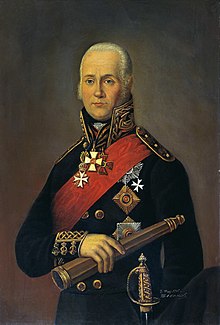Fyodor Ushakov
- See also Admiral Ushakov (warship)

Fyodor Fyodorovich Ushakov (Russian: Фёдор Фёдорович Ушако́в) (February 24, 1744–October 14, 1817) was the most illustrious Russian naval commander and admiral of the 18th century.
Life and naval career
He was born in the village of Burnakovo in the Yaroslavl gubernia, to a modest family of the minor nobility. On February 15, 1761, he signed up for the Russian Navy in Saint Petersburg. After training, he served on a galley in the Baltic Fleet. In 1768 he was transferred to the Don Flotilla (Azov Sea Navy) in Taganrog and served in the Russo-Turkish War, 1768-1774. He commanded Catherine II's own yacht, and later defended Russian trade ships in the Mediterranean from the British pirate attacks.
After Crimea was annexed by the Russian Empire, Ushakov personally supervised the construction of a naval base in Sevastopol and the building of docks in Kherson. During the Second Russo-Turkish War he brilliantly defeated the Turks at Fidonisi, Kerch Strait, Tendra, and Cape Kalakria. In these battles, he demonstrated the excellence of his innovative, Suvorov-influenced doctrines on art of naval fighting.
In 1799, Ushakov was promoted to full admiral and sent to the Mediterranean to support Suvorov's Italian campaign. During this expedition, Ushakov single-handedly carved out the Greek Republic of Seven Islands. He cleared the French from Corfu and all the Ionian islands. His squadron then blocked the French bases in Italy, notably Genoa and Ancona, and successfully assaulted Naples and Rome.
Emperor Paul, in his capacity of the Grand Master of the Order of St John, ordered Ushakov to proceed to Malta, which had been besieged by the British to no effect. Admiral Nelson couldn't bear the idea that he would have to follow Ushakov's orders (the Russian commander being his senior in the naval ranks) and suggested that the Russian squadron should be dispatched to Egypt instead.

Brewing conflict between the commanders was prevented by Ushakov's being recalled to Russia in 1800, where the new Emperor, Alexander I, failed to appreciate his victories. Ushakov resigned command in 1807 and withdrew into the Sanaksar Abbey in modern-day Mordovia. He was asked to command the local militia during the Patriotic War of 1812 but declined.
Tactics
Distinguishing features of Ushakov's tactics were the using of unified marching and fighting orders, resolute rapprochement with the enemy forcies on a short distance without evolution of a fighting order, a concentration of the basic efforts against flagships of the enemy, reserve allocation («Kaiser-flag squadrons»), a combination of aim artillery fire and maneuver, chasing the enemy up to its full destruction or capture. Giving great value to sea and fire training of staff, Ushakov was the supporter of generalissimo Suvorov's principles of training of sailors and officers. Ushakov's innovations were the one of the first successful development of naval tactics from its "line" to manoeuvring concept.
Manoeuvre used by Ushakov in Battle of Cape Kaliakra (1791) was also successfully used by British vice-Admiral Horatio Nelson in Battle of the Nile (1798) and Battle of Trafalgar (1805.)
Memory
On March 3, 1944 the Presidium of the Supreme Soviet of the USSR established the Order of Ushakov which, among several other decorations, was preserved in Russia upon the dissolution of the USSR, thus remaining to be one of the highest military awards in the Russian Federation. In addition to the Order of Ushakov, there have been the Ushakov Medal and several warships named after Admiral Ushakov. The Baltic Navy Institute in Kaliningrad also carries his name. A minor planet 3010 Ushakov discovered by Soviet astronomer Lyudmila Ivanovna Chernykh in 1978 is named after him. [1]
Canonization
The Russian Orthodox Church glorified him as a patron saint of the Russian Navy in 2000. His relics are preserved in Sanaksar. He was also declared the patron saint of Russian nuclear-armed strategic bombers in 2005 by Patriarch Alexius II.
References
External links
- M. Romm Movie (imdb)
- English biography
- Ushakov's Mediterranean campaign
- Ushakov's battleship St Paul
- (Святой морской дьявол) (The holy sea-devil), an article in Kommersant-Dengi (in Russian), available online
- Baltic Navy Institute named after F.F. Ushakov (in Russian) see also [1]
- Sanaksar Monastery - Official site (Russian)
- Sanaksar Monastery - Photo gallery (Russian & English)
